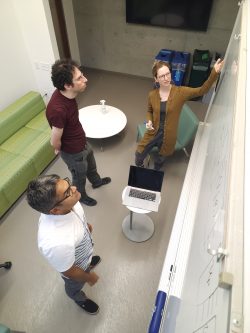ALBUQUERQUE, N.M. — The Russo-Ukrainian conflict and the COVID-19 pandemic have shown how vulnerable global supply chains can be. International events can disrupt manufacturing, delay shipping, induce panic buying and send energy costs soaring.
New research in quantum computing at Sandia National Laboratories is moving science closer to being able to overcome supply-chain challenges and restore global security during future periods of unrest.

“Reconfiguring the supply chain on short notice is an exceptionally difficult optimization problem, which restricts the agility of global trade,” said Alicia Magann, a Truman Fellow at Sandia. She has led the development of a new way to design programs on quantum computers, which she and her team think could be especially useful for solving these kinds of massive optimization problems someday in the future when quantum technology becomes more mature.
The Sandia team recently published the new approach in two joint papers in the journals Physical Review Letters and Physical Review A. Research was funded by the Department of Energy’s Office of Science, Office of Advanced Scientific Computing Research; the DOE Computational Science Graduate Fellowship; and Sandia’s Laboratory Directed Research and Development program.
Optimization algorithms help industry perform tasks like coordinating trucking routes or managing financial assets. These problems are generally difficult to work out, Magann said, and as the number of variables increases, finding good solutions becomes harder.
One of the potential long-term solutions to solving complex optimization problems is to use quantum computers, an emerging technology that experts believe will be able to find answers to some problems much faster than supercomputers.
But building quantum computing technology is only one of the challenges.
“There’s also this other question of: Here’s a quantum computer — how do I actually program this thing? How do I use it?” Magann said.
Better solutions needed for large-scale applications
Researchers around the world are actively developing algorithms for large-scale optimizations on future technologies, with the hope that these programs could help industries manage limited resources more effectively and pivot operations more quickly in the face of rapid changes to the labor market, supplies of raw materials or other logistics.
Mohan Sarovar, the principal investigator on the project, said, “It’s very difficult to come up with quantum algorithms. One of the big reasons for this, apart from quantum computing being very unintuitive, is that we have very few general frameworks for developing quantum algorithms.”
A leading idea for programming quantum optimization algorithms has involved coupling quantum computers and conventional ones to solve a problem together, called the variational approach. The conventional computer performs an optimization of control settings that dictate the behavior of the quantum computer.
One issue with this approach is that its impact is constrained by the ability of the conventional computer to solve optimization problems with a large number of parameters.
Sandia scientist Kenneth Rudinger, who also worked on the project, said the variational approach might not be practical when quantum computers finally become capable of living up to their promise.
“We have good reason to believe that the size of the kinds of problems you would want to solve is too large for the variational approach; at that scale it becomes essentially impossible for the conventional computer to find good settings for the quantum device,” he said.
New framework to solve intricate problems
The Sandia team succeeded in greatly reducing the role of classical computing. With the new framework, called FALQON — short for Feedback-based Algorithm for Quantum Optimization — the classical computer does not do any optimization. It only needs the computational power of a calculator, letting the quantum computer do all the heavy lifting and theoretically allowing it to work on much more complicated problems, like how to efficiently reroute a shipping fleet when a major port suddenly closes.
A framework, in this case, means a structure for how to write an algorithm. Sandia’s core concept is for a quantum computer to repeatedly adapt its structure as it moves through a calculation. Layers of quantum computing gates, the building blocks of quantum algorithms, are determined by measurements of the output of previous layers through a feedback process.
“After I run the first layer of the algorithm, I measure the qubits and get some information from them,” Magann said. “I feed that information back to my algorithm and use that to define the second layer. I then run the second layer, measure the qubits again, feed that information back for the third layer, and so on and so forth.”
Sarovar said, “It defines another class of quantum algorithms that operate through feedback.”
Until quantum computers become more powerful, the framework is largely a theoretical tool that can only be tested on problems classical computers can already solve. However, the team believes the framework shows great potential for formulating useful algorithms for the medium-to-large-scale quantum computers of the future. They are eager to see if it can help develop quantum computing algorithms to solve problems in chemistry, physics and machine learning.